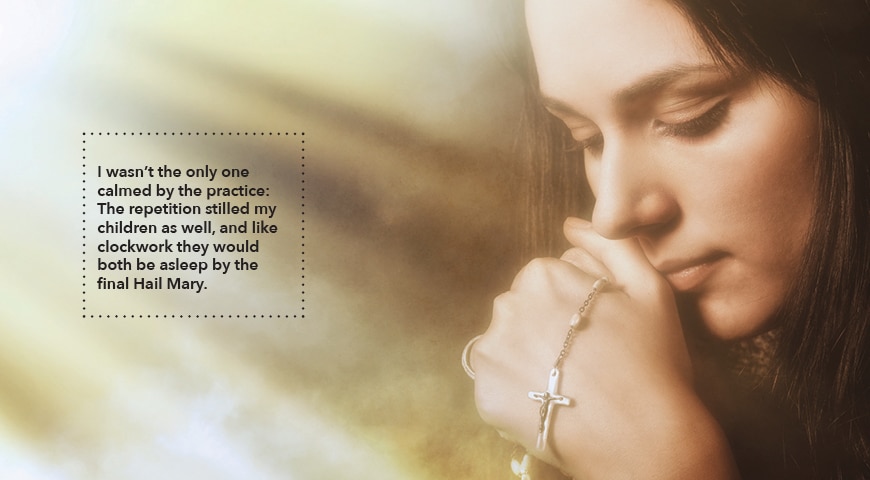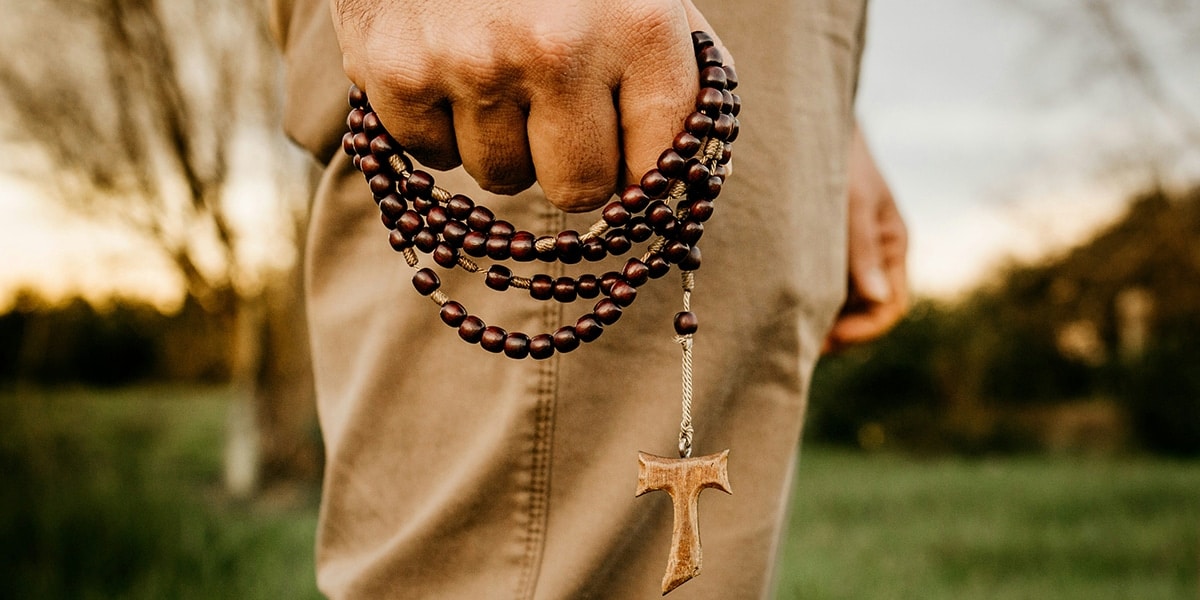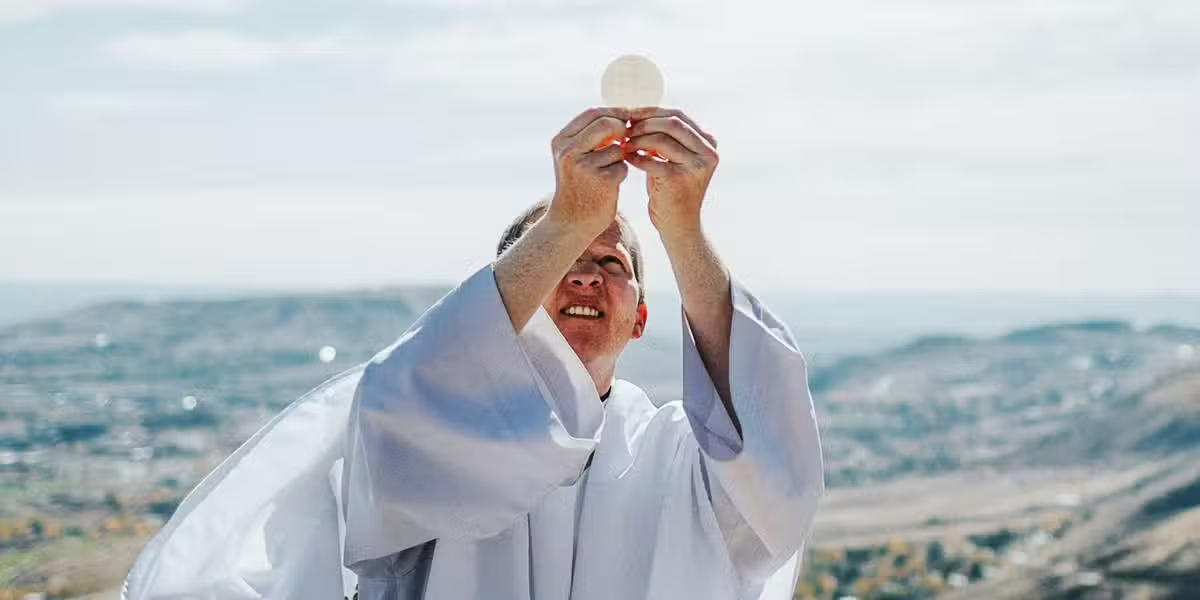There is a path to deeper connection and inner peace if you incorporate the rosary into your daily life.
Growing up as a Protestant kid in the southern United States, I hardly knew what a rosary was, much less how to pray with one. The circular strand of beads seemed to me no more than a collector’s item or baseless superstition. I didn’t know the rosary had a methodology based on Jesus’ life until I went through the Rite of Christian Initiation of Adults (RCIA) at age 30.
By the time I became Catholic, I no longer felt skeptical of the rosary but had no real intention of taking up the practice either. In my early years in the Church, I was given a few sets of beads by enthusiastic cradle Catholics and by my Baptist mother, who admired their beauty in antique stores. But it always felt like a tradition I stood outside of, as though by merit of my conversion I was somehow disqualified from this seemingly complicated set of prayers that my peers had memorized long ago.
But eventually Mary worked her charm on me, and I began longing for a way to incorporate my love for her into my prayer life. I wondered about the rosary: Could this ancient, repetitive practice really hold value for my spiritual life as a modern woman? In some ways it felt doubtful. Yet if the Catholic Church had taught me anything, it was not to discount something because of its age; often the oldest traditions stand the test of time for good reason.
Universal Appeal
The origins of the rosary are muddled to say the least, but we do know pieces of its evolution. Sometime around the year 1221, the Virgin Mary appeared to St. Dominic and urged him to pray the rosary to combat a popular heresy called Albigensianism, which taught that physical matter, including the human body, was evil. Following that apparition, St. Dominic and the Dominican Order played a major role in promoting the rosary all over the world.
That Mary would give her followers a physical tool to help assure them and others of the holiness of the material world feels apropos in the Catholic faith, where Jesus embodied both heaven and earth and where we treasure the sacraments as visible signs of God at work in a world of matter and senses. But interestingly, Catholicism is not the only religion to use prayer beads: Islam, Buddhism, Hinduism, Sikhism, and others have their own variations as well. It seems there is something in the human spirit that gravitates to the repetition and tactile nature of this particular prayer aid.
This was a comforting thing for me to discover as my interest in the rosary grew. Despite the fact that I had not memorized all the scripted prayers and felt helpless to keep the different mysteries straight, the universality of prayer beads helped me believe that my desire to cultivate this practice was not in vain. If millions of people throughout the generations and spanning many religious cultures had found value in it or something similar, surely there was spiritual treasure waiting for me with the rosary.
Eventually, and completely by surprise, I came across a book written by a non-Christian couple who had cultivated an unlikely spiritual connection with Mary through praying the rosary. OK, I finally told myself, if people who are not even Catholic can pray the rosary in a more or less traditionally Catholic way, then surely I can do it, too, no matter how intimidating it seems. I decided to give it a try.
Discovering What Works
Suspecting this could be a devotion that would take a long time to settle into, I committed to praying the rosary every day for one year—and good thing, too, for the learning curve was indeed lengthy. In the beginning I printed out the less familiar prayers so as not to forget them, then later decided to omit the optional ones to keep it simple. Some days I listened to audio recitations to help jog my failing memory. I tried out variations of the wording until I found the form that suited me best.
For a task that sounds so simple—”pray the rosary”—finding my footing took many weeks. But I was surprised to discover that I had a great deal of patience with the process. It somehow felt right to be fumbling my way into this ancient practice, figuring out how to make it feel genuine and authentic to me as a 21st-century millennial woman. After all, anything worth doing is worth doing wholeheartedly. Had I slipped into the rhythm more easily, it likely would not have impacted me so deeply.
It didn’t feel very deep in the beginning. For quite some time, it was a pretty black-and-white way to pray, a near daily experience that was not unwelcome but not particularly transformative either.
Most nights I would tuck my preschoolers into their bunk beds, settle into the rocking chair in the corner of their room, reach behind me to pull the wooden rosary from the shoulder of the chair, and commence my recitations without experiencing much on the inside. Yet even though there were no lightning bolts from heaven, there was something about the practice that centered me.
As I recited the prayers above the dull murmur of my boys’ whispers and wiggles, I felt the stress of the day slowly leave my mind and body. And I wasn’t the only one calmed by the practice: The repetition stilled my children as well, and like clockwork they would both be asleep by the final Hail Mary.
A Feminine Practice
It’s not surprising that praying the rosary fit so seamlessly into my life as a mother. Although plenty of men have benefited from a commitment to the practice, it has been women who have clung most loyally to the little beads throughout the generations. The image of the Catholic grandmother fingering her rosary while working in the kitchen may be clich é, but it is one for a reason.
Praying with the rosary is a spiritual discipline that fits what has historically been the female lifestyle, one that revolves around caring for children and the elderly, surrounded by community, or busied with work in the house or kitchen. While women today have many diverse options for how our daily lives look, the women of previous generations spent much of their time in caregiving and homemaking capacities—a way of life that doesn’t easily lend itself to hours of silence and contemplation.

In my research I learned there may be reason to believe that discrepancies in prayer approaches can be traced back to the hunting and gathering lifestyle of the ancients. What we typically think of as contemplation—sitting still in silence—may have originated from our male ancestors crouching in quiet solitude for hours while out hunting.
Prayer beads, on the other hand, may have emerged from women gathering berries in community with other women and children. While men found themselves alone with hours of silence for meditative prayer, women sought a spiritual practice that could be integrated within the hustle and bustle of their noisier days. Thus, rosaries are a seamless way for a group to pray together in unity or for a woman to pray while stirring a pot of soup with one hand. In my own experience, praying beside my smallest children as they fall asleep is the most natural time in the rhythm of my day.
Opening to the Spirit
As the weeks of my rosary experiment turned into months, I slowly began to notice changes in my experience. I began thinking about how any form of prayer can be made into a superstition if we use it as a bartering tool against God. However, if we accept that prayer might not necessarily change circumstances but can always change us, then a world of spiritual growth opens.
After half a year of praying a daily rosary, my unconscious state became more free as I spoke the words aloud. I noticed my mind wandering to events of the day or conversations that I’d had, and suddenly I would see them in a slightly new way or arrive at novel insights I’d previously missed. As my mind and spirit gradually relaxed into the repetition, I experienced small but not inconsequential phenomena.
One such surprise was the occasional Freudian slip. For example, one particular night when my boys had a hard time winding down, I continued my prayers in the rocking chair while feeling frustrated and annoyed.
Firmly resolving to make it through the entire rosary despite their rambunctious chatter, I was surprised that what accidentally came out of my mouth was “Blessed is the fruit of my womb” rather than the prescribed words to Mary, “Blessed is the fruit of your womb.” Caught off guard at my own slip, I immediately felt recentered in love for my kids, no matter how disruptive, awake, and unruly they were. Speaking an unexpected blessing over them brought me back to a sense of affection and gratitude.
Moments like those did not happen every time, of course, but I did experience noteworthy thoughts or so-called “lightbulb” moments fairly regularly. The practice of making my unconscious self available to the Holy Spirit made its mark, and I found myself wanting to experience it more and more.
An Invitation
As Christians, many of our religious practices revolve around conscious and intentional actions; we make specific choices like attending Mass, partaking of the sacraments, reading Scripture, and praying through a list of intentions. But we don’t always avail ourselves of the practices that allow the Holy Spirit to invade our consciousness and bring us to greater awareness of our own inner life.
There are many such practices within the Catholic tradition: Ignatian prayer, centering prayer, and eucharistic adoration. But praying the rosary might be the most underestimated of them all. For on the surface it may look like mindless repetition—even superstition. But for those who are open to it, the rosary is an invitation for the Spirit to introduce new awareness of God’s presence—and a chance for us to respond to that presence in ways that might permanently change us.
The Joyful Mysteries and Their Fruits
traditionally prayed on Mondays and Saturdays
Annunciation: Humility
Visitation: Love of Neighbor
Nativity of Jesus: Poverty of Spirit
The Presentation: Obedience
Finding Jesus in the Temple: Piety
The Sorrowful Mysteries and Their Fruits
traditionally prayed on Tuesdays and Fridays
Agony in the Garden: Conformity to the Will of God
Scourging at the Pillar: Mortification
Crowning of Thorns: Moral Courage
Carrying the Cross: Patience
Crucifixion: Salvation
The Glorious Mysteries and Their Fruits
traditionally prayed on Sundays and Wednesdays
Jesus’ Resurrection: Faith
The Ascension: Hope
Descent of the Holy Spirit: Wisdom
Assumption of Mary: Devotion to Mary
Coronation of the Blessed Virgin Mary: Eternal Happiness
The Luminous Mysteries and Their Fruits
traditionally prayed on Thursdays
Baptism of Jesus: Openness to the Spirit
Wedding at Cana: Mary’s Intercession
Jesus Proclaims the Kingdom: Repentance and Trust in God
Transfiguration: Desire for Holiness
Institution of the Eucharist: Adoration









4 thoughts on “My One-Year Experiment with the Rosary”
Thank you! Your reflections are helpful and your insights are beautiful.
I am a Catholic convert. I was gifted a rosary at my confirmation. Thank you for sharing your experience. I will find resources to guide me in learning to pray the rosary.
Blessings
Yes please do pray the Rosary. I can personally testify of the powerful intercession of Mary and the graces God dispensed to me through her to fight and overcome my 15 year long struggle with pornography and masturbation as from when I was a teenage boy (I am now 29). I even saw Mary appear in a dream like vision to me on March 2nd 2024 when I was fully asleep calling herself the “Theotokos” wearing all white if you pull up an image of our Lady of Fatima as my soul immediately recognized her as Mary. She spoke to me so gently and softly as she kept me close to her like a Mother does with her small child that I felt something enter into my soul during the moment and then I was taken by Mary to see what Heaven looks like and it’s a place where all desire ceases and just peace, fullness, and completion where struggle and strife and no more with calm and joy beholding the brilliant Glory of God shining as the brightest and purest of white light with the angels circling the throne of God as a living cloud of feathers praising God.
Wow! I love to hear of people’s personal experiences of Mary visiting them.thank you for sharing Geoffrey. God bless you and May the angels bear you up in every circumstance of your life. X